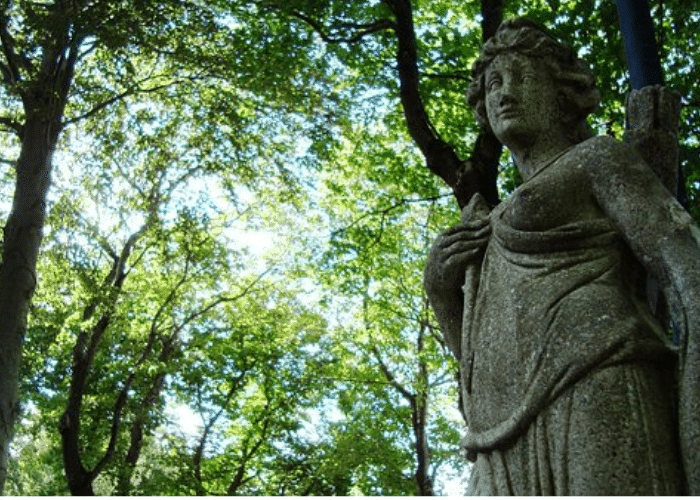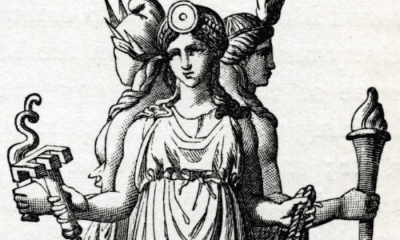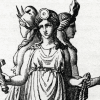
Greek
What is the Symbol of Artemis?
What is the Symbol of Artemis?
Artemis, the goddess of the hunt, had symbols that related almost exclusively to her primary purpose. While this may seem like simple logic, it actually made her very unique among the gods of Greece!
The Greek pantheon had many goddesses who were the patronesses of a wide variety of places, occupations, and ideals. By and large, however, they were depicted in very similar ways.
The Olympians were presented as ideals, and the goddesses were emblems of ideal beauty and femininity. This meant that they were not only physically attractive, but also embodied qualities valued in woman in their society.
Among these goddesses, Artemis is one that stands out.
She was leaner and more athletic than her fellow goddesses. Her clothing would have been scandalous for a proper Greek woman, consisting of a short tunic that did not even cover her knees.
All of this was so Artemis could partake in a distinctly unfeminine activity. The goddess of the hunt lived to run freely through the wild forests of rural Greece, tracking and hunting animals.
While other goddesses were wives, mothers, or obedient daughters, Artemis lived beyond the reach of civilized life.
Her symbolism reflects this. She did not carry flowers or objects of beauty but was instead known for her weapons, hunting dogs, and the wild animals she held sacred.
Images Associated with Artemis
Many of the gods in the Greek pantheon had symbols that were sometimes only vaguely connected to any particular myth. Sometimes the connection between a deity and their attributes was buried in cultures long-forgotten by the classical era.
This was not the case for Artemis, however. The goddess of the hunt had very clear imagery that any person in Greece would recognize the connection to.
The symbols of Artemis were universally related to hunting and the forest. Combined with her distinctive short tunic, which allowed her to move more freely, they made it clear that Artemis was a goddess whose passion and purpose were in the wild.
Artemis and her twin brother Apollo both carried a bow and arrow, which they were sometimes said to have invented as well as perfected. Both were expert marksmen and their arrows were sometimes said to carry disease to those who angered them.
She was also often showed on her unique chariot. Rather than horses, it was pulled by a team of golden deer.
These animals were one of many which were sacred to the forest goddess. The deer that pulled her chariot were the first animals she captured and the entire species was loved by the goddess.
Even more often than deer, Artemis was seen with her pack of hunting dogs. The dogs of Artemis were said to be fast enough to outrun a deer and strong enough to bring down a lion.
She was often shown with just one or two animals as a symbol of her domain, but some writers specified the number and even coloring of her beloved animals. While she had thirteen in total, she only ever hunter with seven, leaving the rest of the pack to rest with her retinue of nymphs.
The strongest animals found in the forests of Greece were also among her favorites. Boars and bears were her favorite prey, but they were also sacred to her and could not be hunted without her permission.
The Calydonian Boar was a particularly fearsome animal sent by Artemis to punish a kingdom that failed to give her the proper respect. When Prince Meleagor was killed while hunting for it, she took pity on his grief-stricken sisters and turned them into her symbolic birds, guinea fowl.
My Modern Interpretation
The relatively straightforward symbolism of Artemis is in contrast to the often complex variety of images associated with some other Greek deities.
Many of the gods of the pantheon were taken from a variety of sources. Then the first Greeks moved into the region in the Bronze Age they encountered the gods of several native cultures and influence from kingdoms like Phoenicia and even Egypt.
As a result, some gods have influences from a variety of sources. Aphrodite, for example, is thought to combine elements of both Near Eastern and Indo-European archetypes, making her function and imagery more diverse than if she had come from a single source.
The fact that Artemis’s symbols and nearly all of her myths center around her one chief function leads many historians to believe that she was not subject to as much outside influence and radical change as some of the other gods of Greece.
In fact, evidence of the goddess of the hunt is among the oldest in the region.
In the Greek region of Attica, there is evidence of a bear cult dating back to the Stone Age. Interestingly, the cave in which this bear spirit was worshiped was later said to be sacred to Artemis and her brother.
In fact, in that region bears were more closely linked to Artemis than any other wild animal. The girls who served at her shrine were called “little bears.”
The Greek word for this is arktos, which some etymologists believe may be related to the goddess’s name.
If Artemis had been worshipped in some form, whether as a goddess or a bear, in that region for thousands of years the iconography of her cult would have been well-established long before Greek speakers brought Zeus to Attica.
Because the bear cult was so well established, it was also hard to add additional attributes to it. While Artemis took some association with the moon and protection, her symbols show that her primary association was always with hunting, animals, and the forest.
Even as Greek culture became more structured and urban, Artemis retained her association with the wild. With the exception of her loyal dogs, the animals associated with her were also known for being impossible to tame and difficult to hunt.
Artemis often seems to defy the standards of Greek culture, even as she was one of its most honored deities. She was a woman who lived in the wild and pursued the traditionally male activity of hunting.
Her incongruity with the other goddesses of the pantheon, like her simpler symbolism, may be a sign that she was not a Greek goddess at all. She predated the cities and institutions that defined Greek culture by thousands of years.
In Summary
As the goddess of the hunt, Artemis had much different iconography than most goddesses of Greece. In addition to having a different body type and style of dress, both more suitable for running in the forest than sitting at home, Artemis also had distinct symbolism.
Her iconography was all distinctly connected to the wild, and specifically to her love of hunting. One of her most iconic attributes was the bow and arrow she carried, with which she was an expert shot.
She surrounded herself with a pack of hunting dogs rather than objects of beauty. Her sacred animals were held in high regard specifically because they were hard to catch and impossible to keep captive.
Even her chariot reflected her role in the wild. Rather than horses or fanciful beasts, it was pulled by a team of deer that only Artemis was capable of capturing and training.
The fact that her iconography is so intrinsically tied to her function indicates that her function had not changed much throughout history. She had acquired few new roles or duties, but had remained far more consistent than some of the more complicated deities of Greece.
In fact, evidence of the same iconography at sites sacred to Artemis date back to the Stone Age in Greece. It seems likely that Artemis was a direct descendent of this prehistoric animal cult and had relatively little influence from outside religions.



